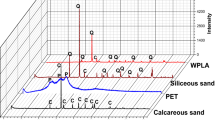Abstract
The planet has been facing several environmental problems, most of which come from civil construction waste, which, in addition to being a major polluting source, still requires a large amount of raw materials removed from the environment. In order to minimize these damages, the present work aims to reduce the extraction of sand from river beds and reduce the incorrect disposal of packaging produced with polyethylene terephthalate (PET) through the partial replacement of the fine aggregate by PET in the production of mortars. Prismatic specimens were be produced with curing in 28 days of 25 °C and partial replacement of 10, 20 and 30% of the natural sand by the waste. Tests were performed on consistency, viscosity, density, mechanical strength and capillarity will be performed tests. The results showed that the partial replacement of natural sand by PET is feasible, despite some observed viscosity losses, making this mortar more ecological.
Access this chapter
Tax calculation will be finalised at checkout
Purchases are for personal use only
Similar content being viewed by others
References
Fanran M, Aritha D, Simon JMM, Gavin HT, Alex C, Jon M (2021) Bioethanol from self-contained municipal solid waste: environmental and financial feasibility assessment under political contexts, aplic. Energy. https://doi.org/10.1016/j.apenergy.2021.117118
Nikita G, Rafat S, Rafik B (2021) Sustainable and greener self-compacting concrete incorporating industrial by-products: a review. J Clean Prod. https://doi.org/10.1016/j.jclepro.2020.124803
Wahid F, Allan M, Rafat S, Priyan M, Yan Z, Hong SW, Weena L, Thiru A, Peter S (2021) Recycling of landfill wastes (tyres, plastics and glass) in construction—a review on global waste Generation, performance, application and future opportunities. Resour Conserv Recycl. https://doi.org/10.1016/j.resconrec.2021.105745
Laura JG, Sam AW, Claire LC, Susan AB, Valentin L, Martin CS, John LP, Neil CH (2021) Temperature transformation of blended magnesium potassium phosphate cement binders. Cemente Concr Res. https://doi.org/10.1016/j.cemconres.2020.106332
Syed MSK, Muhammas JM, Yu-Fei W (2021) Application of waste tire rubber and recycled aggregates in concrete products: a new compression casting approach. Resour Conserv Recycl. https://doi.org/10.1016/j.resconrec.2020.105353
Mikael K, Dominique F, Gwénael LM, Stéphane B (2020) Why is there plastic packaging in the natural environmente? Understanding the roots of our individual plastic waste management behaviours, science of the total environmente. https://doi.org/10.1016/j.scitotenv.2020.139985
Khawla C, João PC, Ahmed W, Ana VG, Olfa H, Armando CD, Teresa RS, Mohamed K (2019) Microplastic pollution in the sediments of Sidi Mansour Harbor in Southeast Tunisia. Mar Pollut Bull. https://doi.org/10.1016/j.marpolbul.2019.06.004
Yasuhiko H, Chettiyapan V, Michikazu K, Agamuthu P (2016) Development of 3R policy indicators for the Asia-Pacific region: experience of the 3R Regional Forum in Asia and the Pacific. J Mater Waste Manage Cycl. https://doi.org/10.1007/s10163-015-0442-3
NBR 13276 (2002) Mortar for laying and coating walls and ceilings—preparation of the mixture and determination of the consistency index. Brazilian Technical Standards Association
NBR 13279 (2005) Mortar for laying and coating walls and ceilings—determination of tensile strength in bending and compression. Brazilian Technical Standards Assoc
NBR 15259 (2005) Mortar for laying and coating walls and ceilings—determination of water absorption by capillarity and capillarity coefficient
Nabajyoti S, Jorge B (2012) Use of plastic waste as aggregate in the preparation of cement and concrete mortar: a review. Constr Build Mater. https://doi.org/10.1016/j.conbuildmat.2012.02.066
Luciano DM, Bartolomeo C, Luc C, Frédéric M, Loredana I, Paola S (2018) Data on termal conductivity, water vapour permeability and water absorption of a cementitious mortar containing end-of-waste plastic aggregates. Constr Build Mater. https://doi.org/10.1016/j.dib.2018.03.128
Marvila MT, Azevedo ARG, Alexandre J, Zanelato EB, Azeredo NG, Simonassi NT, Monteiro SN (2019) Correlation between the properties of structural clay blocks obtained by destructive tests and ultrasonic pulse tests. J Build Eng. https://doi.org/10.1016/j.jobe.2019.100869
Azevedo ARG, Marvila MT, Zanelato EB, Alexandre J, Xavier GC, Cecchin D (2020) Development of mortar for laying and coating with pineapple fiber. Revista Brasileira De Engenharia Agricola e Ambiental 24(3):187–193. https://doi.org/10.1590/1807-1929/agriambi.v24n3p187-193(InPortuguese)
Carvalho A, Xavier GC, Alexandre J, Pedroti LG, de Azevedo ARG, Vieira CMF, Monteiro SN (2014) Environmental durability of soil-cement block incorporated with ornamental stone waste. https://doi.org/10.4028/www.scientific.net/MSF.798-799.548
Acknowledgements
This research was funded by the State University of the Northern Fluminense (UENF), partially financed by CAPES (Coordenação de Aperfeiçoamento de Pessoal de Nível Superior—Brazil), CNPq (Coordenação Nacional de Pesquisa) and FAPERJ (Fundação de Apoio à Pesquisa do Estado do Rio de Janeiro). The participation of A.R.G.A. was sponsored by FAPERJ through the research fellowships proc.no: E-26/210.150/2019, E-26/211.194/2021, E-26/211.293/2021, E-26/201.310/2021, and by CNPq PQ2 307592/2021-9.
Author information
Authors and Affiliations
Corresponding author
Editor information
Editors and Affiliations
Rights and permissions
Copyright information
© 2023 The Minerals, Metals & Materials Society
About this paper
Cite this paper
Batista, I.D. et al. (2023). Eco-Friendly Mortar with Partial Replacement of the Fine Aggregate by Polyethylene Terephthalate (PET). In: Zhang, M., et al. Characterization of Minerals, Metals, and Materials 2023. TMS 2023. The Minerals, Metals & Materials Series. Springer, Cham. https://doi.org/10.1007/978-3-031-22576-5_34
Download citation
DOI: https://doi.org/10.1007/978-3-031-22576-5_34
Published:
Publisher Name: Springer, Cham
Print ISBN: 978-3-031-22575-8
Online ISBN: 978-3-031-22576-5
eBook Packages: Chemistry and Materials ScienceChemistry and Material Science (R0)




